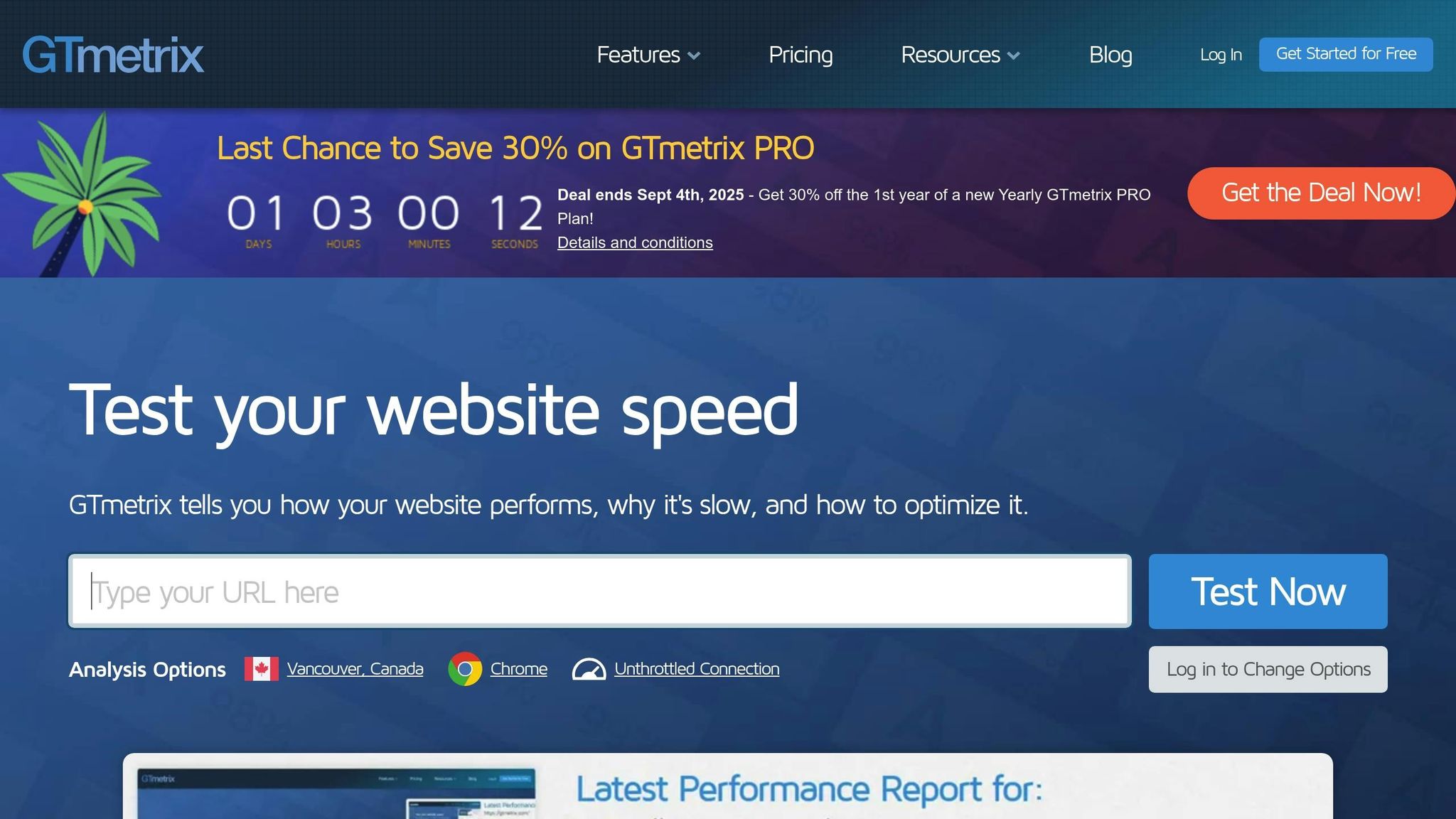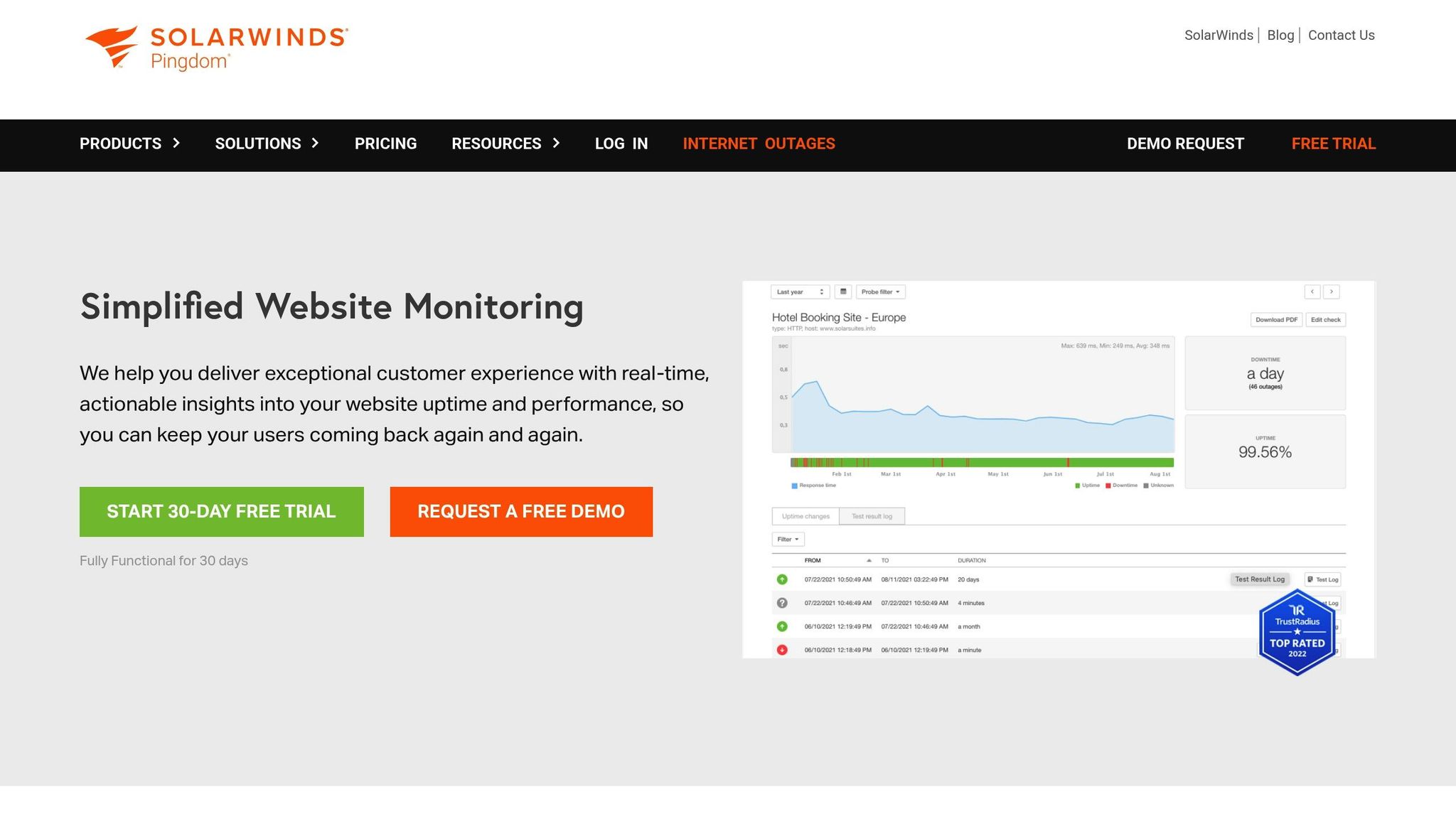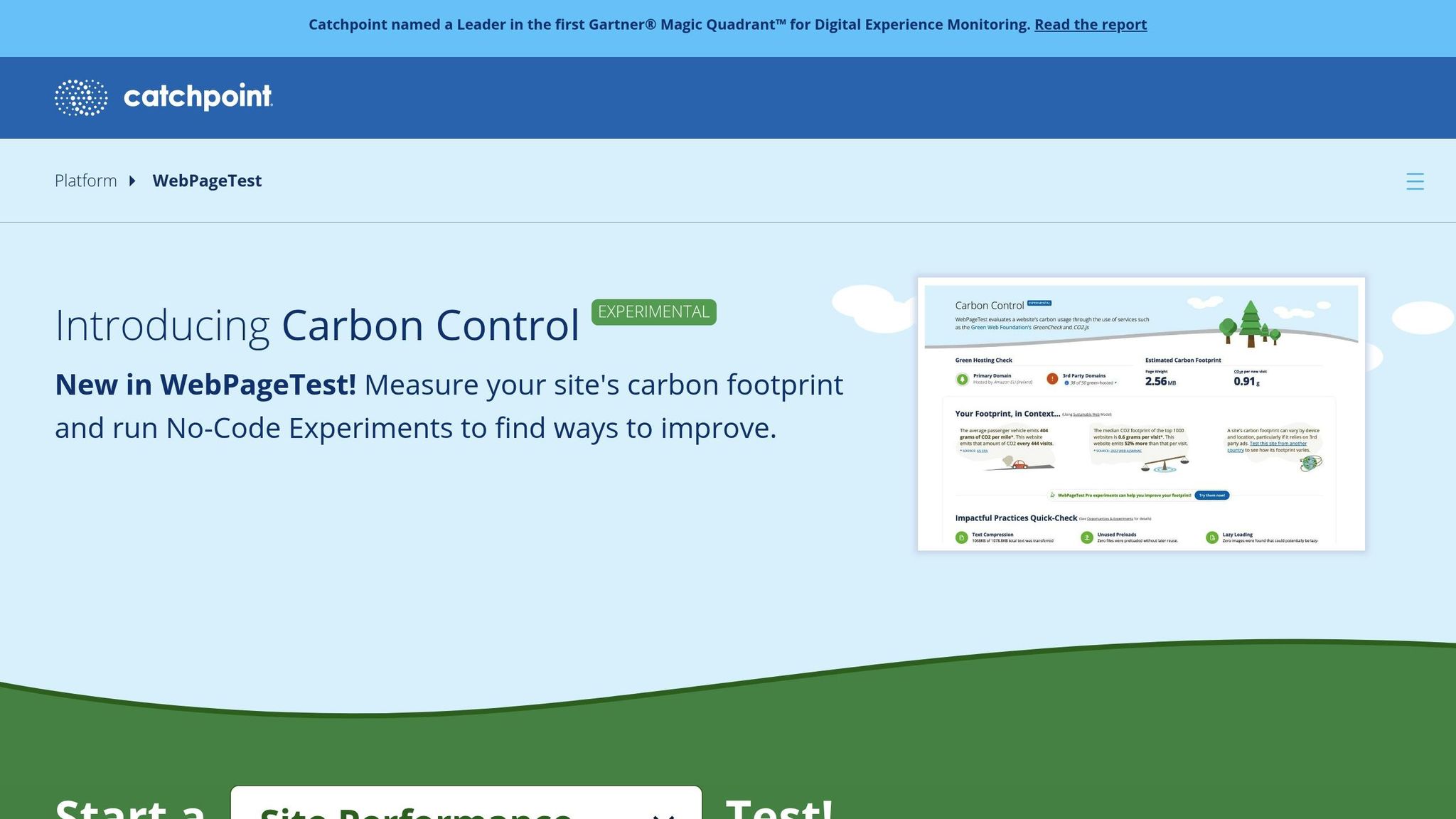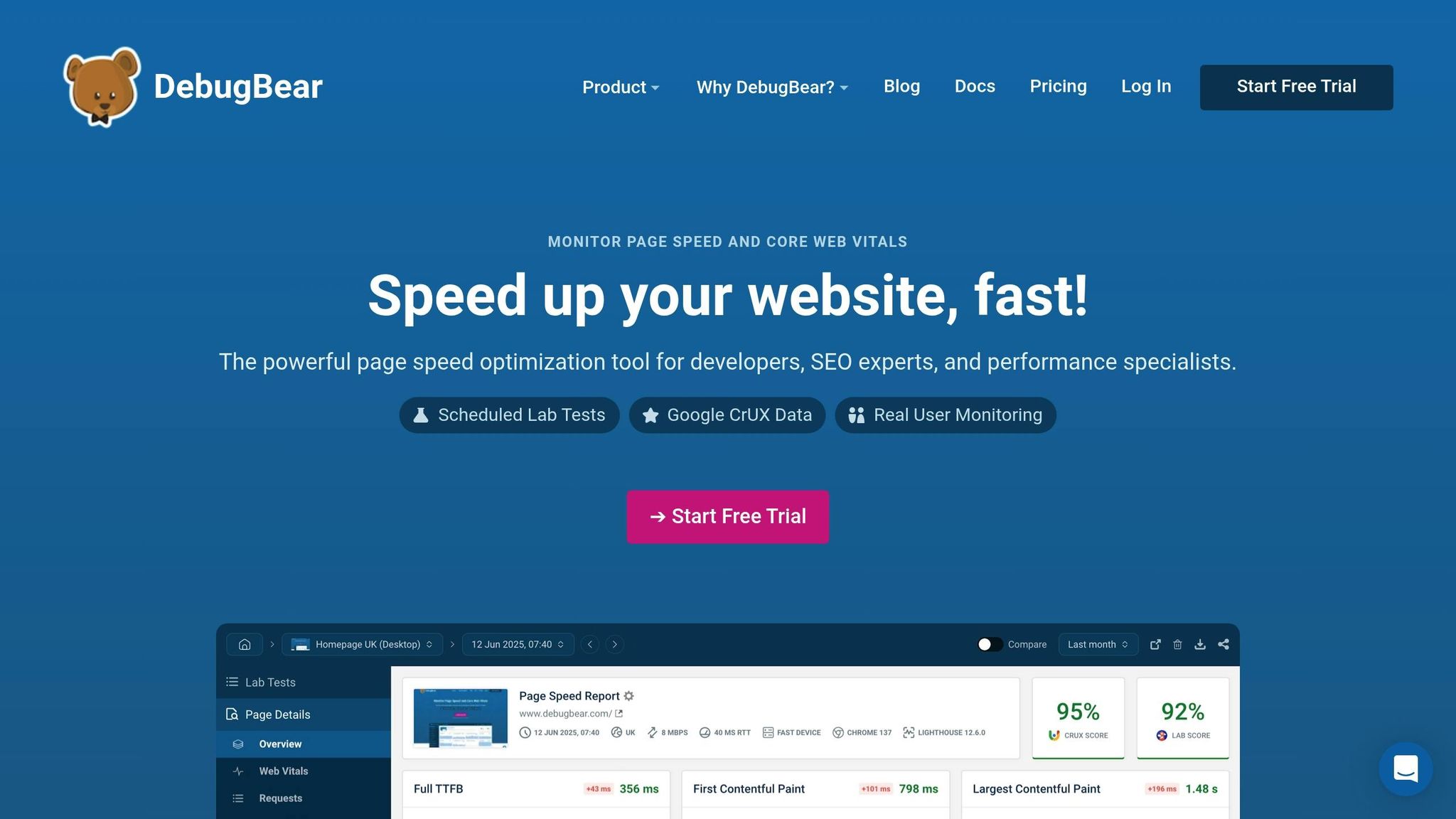Top Tools For Measuring Job Board Site Speed
Your job board's speed can make or break its success. A slow site frustrates users, hurts SEO rankings, and reduces conversions. To stay competitive, you need tools that measure and improve site performance effectively.
Here’s a quick rundown of five tools to evaluate and optimize your job board's speed:
- Google PageSpeed Insights: Free tool analyzing mobile and desktop performance, focusing on Core Web Vitals with actionable tips.
- GTmetrix: Combines Google Lighthouse data with detailed waterfall charts and multi-location testing. Free and premium plans available.
- Pingdom: Simple interface with global testing locations and real-time performance monitoring.
- WebPageTest: Advanced testing with filmstrip views, network simulation, and API access for developers.
- DebugBear: Continuous monitoring with device-specific insights and network throttling.
Each tool offers a unique perspective, from quick checks to deep analysis and ongoing monitoring. Whether you’re just starting or need advanced features, there’s an option to fit your needs.
Quick Comparison
| Tool | Key Features | Pricing | Best For | Limitations |
|---|---|---|---|---|
| Google PageSpeed Insights | Core Web Vitals, mobile/desktop analysis | Free | Beginners, SEO improvements | Limited historical data |
| GTmetrix | Waterfall charts, video playback | Free; $14.95+/mo | Detailed analysis, monitoring | Free plan has usage caps |
| Pingdom | Uptime monitoring, global testing | Free; $10+/mo | Quick tests, real-time alerts | Limited free testing locations |
| WebPageTest | Filmstrip view, connection simulation | Free; $200+/mo | Developers, in-depth testing | Complex interface, requires expertise |
| DebugBear | Continuous monitoring, network throttling | Free; varies | Ongoing tracking, insights | Newer platform, fewer integrations |
Pro Tip: Start with free tools like Google PageSpeed Insights for basic improvements. For deeper insights or automated tracking, consider upgrading to premium plans from GTmetrix or DebugBear. A fast site isn’t just about performance - it’s about keeping users engaged and satisfied.
How To Test The Speed Of Your Website
1. Google PageSpeed Insights

Google PageSpeed Insights is a free tool designed to evaluate your job board's speed by analyzing specific URLs. This tool, created by Google, offers a quick and efficient way to check the performance of your site's pages.
What makes PageSpeed Insights stand out is its dual approach to measuring performance. It combines lab data - collected from simulated environments - with field data gathered from real users via the Chrome User Experience Report. This blend provides a clearer picture of how your site performs in actual conditions.
Mobile and Desktop Performance Testing
The tool generates separate reports for mobile and desktop versions of your site. Given the heavy reliance on mobile devices, having this distinction is crucial. PageSpeed Insights also evaluates Core Web Vitals, such as loading speed, interactivity, and visual stability. These metrics provide a well-rounded view of your site's performance and highlight areas that need attention. Alongside these insights, the tool offers tailored tips to help you make targeted improvements.
Actionable Recommendations
One of the best features of PageSpeed Insights is its practical improvement suggestions. As Tom Shapiro, CEO of Stratabeat, puts it:
"It's not 100 percent accurate, but it is a guide. So I would use it as a directional guide as opposed to, say, something that is definitive."
The tool often recommends steps like optimizing images, reducing server response times, enabling browser caching, and minifying CSS and JavaScript. These changes can significantly improve your site's speed and user experience. Prioritizing fixes related to Core Web Vitals is especially important since they can directly impact your site's search rankings.
Pricing
The best part? Google PageSpeed Insights is completely free to use. There are no hidden costs, premium features, or usage limits. You can run as many tests as you need on any page of your job board. While the tool identifies issues and provides solutions, implementing those fixes will fall to your development team.
Reports are generated using Google's servers, meaning all tests are conducted from a single location. This consistency ensures reliable results every time.
2. GTmetrix

When it comes to job boards, speed is everything. GTmetrix offers the tools to identify and fix slowdowns, combining Google Lighthouse data with its own testing engine to deliver precise performance insights.
With its detailed waterfall charts, GTmetrix shows exactly how each element of your job board loads. This makes it easy to spot the scripts, images, or integrations that are dragging down your site’s speed.
Multi-Location Testing and Real-World Simulations
GTmetrix allows you to test your site from various global locations. Free users are limited to Vancouver, but premium accounts unlock additional locations like Dallas, Hong Kong, London, Mumbai, São Paulo, and Sydney.
The tool also simulates different connection speeds and devices, which is especially useful for understanding how your job board performs on slower 3G networks. Since many job seekers use mobile devices with limited bandwidth, this feature helps you optimize for real-world browsing conditions. Whether testing a high-speed desktop connection or a slower mobile network, GTmetrix provides a clear picture of your site’s performance.
Mobile and Desktop Performance Insights
GTmetrix evaluates both mobile and desktop performance separately, using Chrome's mobile emulation to highlight device-specific differences.
It tracks key metrics like Largest Contentful Paint (LCP), Total Blocking Time (TBT), and Cumulative Layout Shift (CLS) - all part of Google’s Core Web Vitals. These metrics directly influence your job board's search rankings, and GTmetrix presents them with color-coded scores to help you quickly identify problem areas.
Clear, Actionable Fixes
GTmetrix doesn’t just point out issues - it provides step-by-step recommendations to fix them. Whether it’s compressing oversized images, reducing CSS file sizes, or enabling lazy loading, the tool prioritizes fixes to help you address the most pressing performance bottlenecks first. It even highlights render-blocking resources, giving you a roadmap to improve loading times for job listings and applications.
Free and Premium Options
The free version of GTmetrix lets you run three tests per day from Vancouver using Chrome simulation. For those needing more, premium plans start at $14.95/month. These plans include perks like testing from multiple locations, running up to 100 tests daily, video capture, historical performance tracking, and alerts when your site’s performance dips.
Whether you’re looking for basic performance checks or comprehensive monitoring, GTmetrix offers flexible options to fit your needs.
3. Pingdom

Pingdom stands out with its straightforward interface, making it a go-to choice for job board owners who need quick and clear performance insights. Like other tools, it helps identify performance issues, but its intuitive design simplifies the process. One of its key features is a visual breakdown of how your site loads, presented through an easy-to-read waterfall chart. This makes spotting bottlenecks that could slow down the experience for job seekers much easier.
Multi-Location Testing and Real-World Accuracy
One of Pingdom's strengths is its ability to test your site from multiple global locations. This feature gives you a clear picture of how your job board performs in different regions, which is especially useful if you're catering to an international audience. By using live data centers for testing, Pingdom provides results that reflect real-world conditions, offering a more accurate representation of your site's speed compared to lab-based metrics.
Key Performance Metrics
Pingdom focuses on essential performance metrics, offering insights into load times and overall efficiency. Its user-friendly dashboard presents this information in a way that's easy to understand, allowing you to quickly identify areas for improvement. Whether it's reducing load times or optimizing resource usage, Pingdom helps you make changes that enhance the user experience on your job board.
Practical Optimization Tips
Pingdom doesn’t just highlight issues - it provides practical recommendations to fix them. For example, it might suggest compressing large images, cleaning up bulky CSS files, or addressing slow third-party integrations. These actionable tips ensure that critical features like job listings and application forms load quickly and smoothly, keeping job seekers engaged.
Pricing Options
Pingdom offers both free and premium plans. The free version is great for basic performance monitoring, while the premium option unlocks advanced features like higher testing limits, access to historical performance data, and uptime monitoring. These additional tools can help you maintain a fast, reliable job board that meets the needs of your audience.
sbb-itb-316a34c
4. WebPageTest

WebPageTest is a powerful tool for evaluating website performance, offering detailed metrics across devices and networks. It provides a clear breakdown of how your site loads and what happens during the process, giving you a better understanding of the overall user experience.
One of its standout features is the filmstrip view, which visually illustrates the loading process step by step.
Mobile and Desktop Performance Testing
WebPageTest is particularly effective at assessing how your job board performs on both mobile and desktop devices. By testing under real-world conditions, it allows you to see how essential components - like job listings, search features, and application forms - function across smartphones, tablets, and desktops.
The tool separates mobile and desktop metrics, enabling you to fine-tune each interface for optimal performance.
Multi-Location Testing and Network Simulation
Another key advantage of WebPageTest is its ability to run tests from multiple locations worldwide. This provides valuable insights into how your job board performs for users in different regions.
Additionally, it simulates various network speeds, from high-speed broadband to slower mobile connections. The filmstrip view captures the page’s loading process frame by frame, making it easier to pinpoint when critical elements, like job search results, appear on the screen.
Practical Recommendations
WebPageTest doesn’t just identify issues - it provides actionable suggestions. For instance, it might recommend optimizing image sizes, reducing server response times, or improving how resources are loaded. For job boards, this could mean resizing thumbnail images or streamlining the application process to enhance speed and usability.
The tool also features waterfall charts that outline the sequence of resource loading. This helps you focus on the changes that will have the biggest impact on user experience. Performance grades for different aspects make it easy to track progress over time.
For job board operators using Job Boardly, WebPageTest insights can complement the platform's robust features. By addressing specific performance issues, you can ensure candidates enjoy a fast, seamless browsing experience - perfect for keeping them engaged.
Use these insights alongside findings from other tools to take your job board’s performance to the next level.
5. DebugBear

DebugBear provides a powerful tool for monitoring performance, blending real-time tracking with in-depth analysis. Unlike tools that only give you occasional updates, DebugBear keeps an eye on your job board's performance around the clock, sending alerts whenever potential problems arise. It also ensures you can evaluate performance across various devices.
Mobile and Desktop Performance Testing
With DebugBear, you can analyze performance separately for mobile and desktop users. For example, it can highlight cases where application forms load quickly on a desktop but lag on mobile, helping you focus your optimization efforts where they’re needed most.
Simulating Real-World Conditions
DebugBear replicates different network speeds and device setups to show how your job board performs for users in various scenarios. Whether someone is on high-speed broadband or a slower mobile network, DebugBear’s network throttling tests reveal how your site handles these conditions.
Practical Recommendations
The tool doesn’t just flag problems - it suggests specific fixes. From compressing images to reducing JavaScript bundle sizes or introducing lazy loading, DebugBear provides clear steps to improve your job board’s performance.
Pricing and Plans
DebugBear operates on a freemium model. A basic free plan is available for beginners, while premium plans unlock features like continuous monitoring, custom alerts, and access to detailed historical data. For the latest pricing details and plan features, visit DebugBear’s official website.
Job Boardly users can integrate DebugBear’s insights to fine-tune their platform, ensuring a fast and responsive experience for job seekers.
With its continuous monitoring and actionable recommendations, DebugBear is a solid addition to any performance optimization toolkit, helping you maintain consistent site speed and reliability over time.
Tool Comparison Table
Choose the tool that aligns with your needs, budget, and technical setup. Here’s a quick breakdown of the most popular options:
| Tool | Key Features | Pricing (USD) | Best For | Limitations |
|---|---|---|---|---|
| Google PageSpeed Insights | Core Web Vitals, mobile/desktop analysis, free optimization tips | Free | Quick assessments, SEO improvements, beginners | Limited historical data, basic reporting |
| GTmetrix | Waterfall charts, video playback, performance tracking, alerts | Free tier; Pro starts at $14.95/month | Detailed analysis, ongoing monitoring | Free plan has usage caps, advanced features require payment |
| Pingdom | Global test locations, uptime monitoring, real user monitoring, alerts | Free tier; paid plans from $10/month | Uptime tracking, simple interface, quick tests | Limited free testing locations, fewer optimization insights |
| WebPageTest | Advanced testing options, filmstrip view, connection simulation, API access | Free with limits; paid plans start at $200/month | In-depth technical testing, development teams | Requires technical expertise, complex interface |
| DebugBear | Continuous monitoring, mobile/desktop testing, network throttling, actionable insights | Free tier; premium plans vary | Ongoing performance tracking, real-world simulation | Newer platform, fewer integrations |
Each tool has its strengths and is suited to specific use cases. For smaller job boards, Google PageSpeed Insights and free plans from other tools are often enough to handle basic optimization tasks. On the other hand, larger platforms managing high traffic or frequent applications benefit from paid plans that offer continuous monitoring and more advanced analytics.
Google PageSpeed Insights is a great starting point for improving SEO, as it provides actionable insights that directly influence search engine rankings. If you’re looking for more detailed performance data without committing to a budget, GTmetrix is an excellent choice, offering robust analysis even on its free tier.
For Job Boardly users, combining Google PageSpeed Insights for SEO-focused improvements with GTmetrix for deeper performance analysis can cover both search engine requirements and user experience optimization - without requiring a significant financial investment.
When it comes to integrations, WebPageTest stands out with API access, ideal for developers automating performance testing in their workflows. Meanwhile, Pingdom is perfect for real-time alerts, ensuring you’re notified immediately of performance issues during peak traffic times.
The tools also differ in ease of use. Google PageSpeed Insights is beginner-friendly, requiring little to no technical knowledge, making it accessible for job board owners without a development background. In contrast, WebPageTest is better suited for those with technical expertise, offering advanced control over testing parameters and conditions for more granular insights.
Conclusion
Keeping a close eye on your site’s speed isn’t just a nice-to-have - it’s a must for staying ahead in today’s competitive market. Your site’s speed can directly influence your success, affecting everything from user satisfaction to your revenue.
Each tool mentioned in this guide brings something different to the table when it comes to optimizing performance. Google PageSpeed Insights lays the groundwork for SEO improvements, making it easier for job seekers to discover your platform. GTmetrix dives deep into performance data, helping you pinpoint specific issues that might be driving users away during critical moments. Pingdom ensures you're notified instantly if something goes wrong, while WebPageTest equips your development team with advanced tools for fine-tuning your site.
Regular monitoring is key to avoiding slowdowns. Tools like GTmetrix or DebugBear can automate this process, helping you catch potential issues before they impact users. This is especially important for job boards, where even a slight delay can push candidates toward a competitor’s faster site.
For users of Job Boardly, mixing free and paid tools is a smart way to build an effective monitoring system without breaking the bank. Start with free options for basic testing, and as your site grows, invest in premium tools to handle increased demands.
Speed optimization isn’t a one-time task - it’s an ongoing effort. Regular testing and improvements ensure your platform remains fast and dependable, keeping both job seekers and employers engaged and satisfied. A fast site isn’t just about performance; it’s about delivering an experience that keeps people coming back.
FAQs
What are the differences between free and premium plans for tools that measure job board site speed?
Free tools like Google PageSpeed Insights and GTmetrix provide a good starting point for analyzing website performance. They offer basic features like speed scores and general recommendations, which can help you identify initial areas for improvement. However, these free plans often lack the depth needed for more thorough optimization.
If you're looking for more comprehensive features, premium options are worth considering. For instance, Google PageSpeed Insights Pro (priced around $10/month) and GTmetrix Premium (starting at $14.50/month) come packed with extras. These include advanced testing capabilities, detailed reports, access to premium test locations, faster processing times, and historical data tracking. These features are particularly useful if you’re focused on fine-tuning your job board site's speed and need tools that offer greater flexibility and precision.
How do Core Web Vitals improve job board performance and SEO rankings?
Core Web Vitals are essential for boosting the performance of job boards and improving their SEO rankings. These metrics focus on three critical aspects of user experience: how quickly your site loads, how responsive it is to user interactions, and how stable the visuals are as the page renders. In short, they ensure your site feels fast, smooth, and reliable for visitors.
Meeting Core Web Vitals benchmarks can make a huge difference. It not only helps your job board rank higher on search engines but also attracts more organic traffic and keeps users engaged longer. The result? Greater visibility, more consistent traffic, and a stronger foundation for growth over time.
What is the best way for job board owners to choose a site speed measurement tool that fits their needs and budget?
When picking a tool to measure site speed, job board owners should think about their goals, technical expertise, and budget. Google PageSpeed Insights is a free and straightforward option, perfect for smaller job boards or those working with limited resources. It offers quick and basic insights into performance, making it a solid starting point.
For those who need more detailed reports, GTmetrix provides advanced analysis and customization options. This can be especially useful for larger or more complex job boards, though it may come with a higher price tag.
The best choice depends on how much detail you’re looking for and what you’re willing to spend. Focus on the performance metrics that matter most to your job board’s success, and select a tool that fits those needs.
